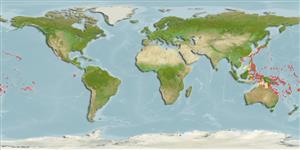Actinopterygii (peixes com raios nas barbatanas) >
Perciformes (Perch-likes) >
Xenisthmidae (Collared wrigglers)
Etymology: Xenisthmus: Greek, xenos = strange + Greek, isthmos = throat, narrow passage (Ref. 45335); eirospilus: Name from the Greek 'eiro' meaning to join in lines or string together, and 'spilos' for spot or fleck, refers to the prominent pattern of closely spaced dark spots on the mid-side; noun in apposition.. More on author: Gill, Hoese.
Ambiente / Clima / Intervalo
Ecologia
; marinhas demersal; intervalo de profundidade 0 - 35 m (Ref. 59014), usually 0 - 10 m (Ref. 90102). Tropical, preferred ?
Southwestern Pacific: Tasman Sea and the Solomons.
Tamanho / Peso / Idade
Maturity: Lm ? range ? - ? cm
Max length : 1.8 cm SL macho/indeterminado; (Ref. 59014); 2.1 cm SL (female)
Descrição suscinta
Morfologia | Morfometria
Espinhos dorsais (total): 7; Raios dorsais (total): 12-13; Espinhos anais 1; Raios anais : 11 - 12; Vértebras: 27. This species is characterized by the following: second dorsal-fin rays I, 12-13 (usually I, 12); A I, 11-12 (usually I, 11); vertebrae 10 + 17; indented tongue; posterior naris with well-developed flap on anterior rim; upper sides of the body with 12 large, closely spaced spots, these usually do not extend to dorsal edge of body; predorsal area broadly scaled to about vertical through posterior edge of preopercle (Ref. 59014).
A benthic, inshore species found in coral reefs (Ref. 75154). Also found in sand patches among reefs and rubble, often in surge areas (Ref 90102).
Life cycle and mating behavior
Maturidade | Reprodução | Desova | Ovos | Fecundidade | Larvas
Gill, A.C. and D.F. Hoese, 2004. Three new Australian species of the fish genus Xenisthmus (Gobioidei: Xenisthmidae). Rec. Aust. Mus.56(2):241-246. (Ref. 59014)
Status na Lista Vermelha da IUCN (Ref. 115185)
CITES (Ref. 94142)
Not Evaluated
Perigo para os humanos
Harmless
Uso pelos humanos
Mais informação
Nomes comunsSinônimosMetabolismoPredadoresEcotoxicologiaReproduçãoMaturidadeDesovaFecundidadeOvosDesenvolvimento dos ovos
Idade/TamanhoCrescimentoComprimento-pesoComprimento-comprimentoFrequências de comprimentoMorfometriaMorfologiaLarvasDinâmica larvalRecrutamentoAbundância
ReferênciasAquaculturaPerfil para aquaculturaEstirpesGenéticaFrequência alélicaHereditariedadeDoençasProcessamentoMass conversion
ColaboradoresFotosStamps, CoinsSonsCiguateraVelocidadeTipo de nataçãoÁrea branquialOtólitosCérebrosVisão
Ferramentas
Relatórios especiais
Baixar XML
Fontes da internet
